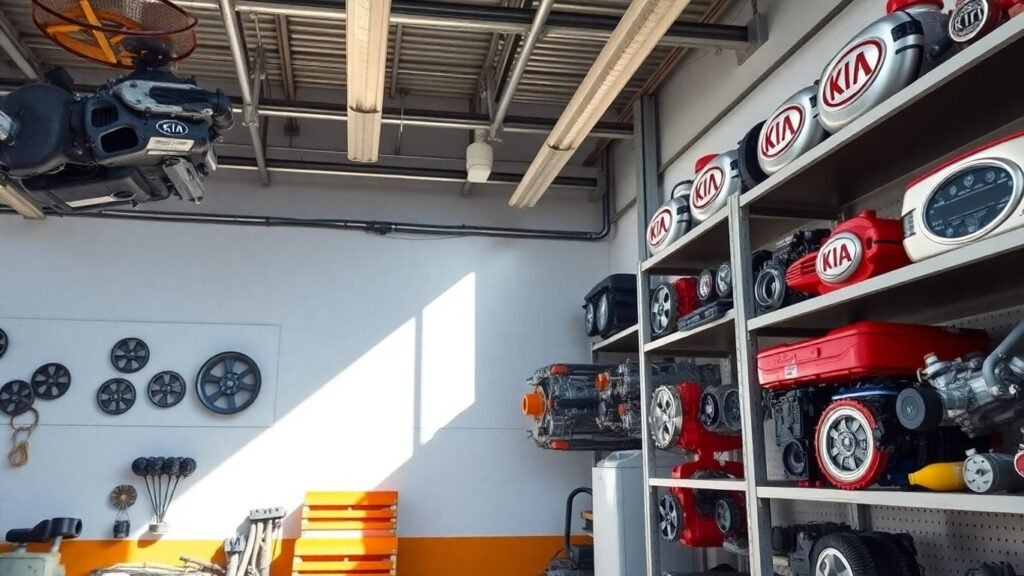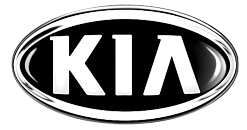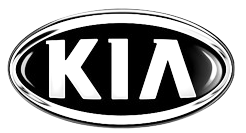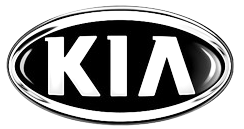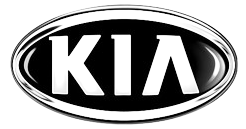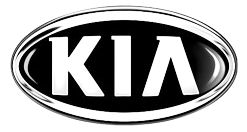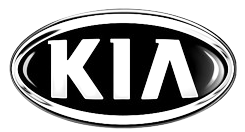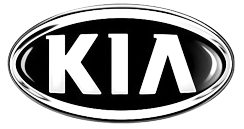Finding the right used parts for your Kia can feel like a treasure hunt. Whether you’re a DIY mechanic or just need a specific component to get your car back on the road, knowing where to look is key. This guide will help you find Kia dismantlers for used parts, covering everything from online searches to what to expect when you visit a salvage yard. We’ll also touch on why choosing used parts is a good idea and how it helps the environment.
Key Takeaways
- Using Kia dismantlers for used parts is a cost-effective way to get quality components for your vehicle.
- Online part locators and salvage yard inventories can help you find specific Kia parts quickly.
- Always check the condition of used parts and understand the warranty or return policy before buying.
- Be aware of safety rules and potential hazards when visiting physical dismantling yards.
- Recycling auto parts through dismantlers reduces waste and has a positive environmental impact.
Locating Kia Dismantlers for Used Parts

Understanding the Benefits of Used Kia Parts
Buying used parts for your Kia can be a smart move. You’re often getting genuine Kia components that were originally designed for your specific model, but at a much lower cost than new ones. This is especially helpful if your Kia is an older model, as finding new parts can sometimes be a challenge. Plus, by reusing parts, you’re doing a good thing for the environment by reducing waste. It’s a win-win, really – saving money and helping the planet.
How to Find Reputable Kia Dismantlers
Finding a good place to get used Kia parts isn’t too hard if you know where to look. Start by searching online for "Kia dismantlers" or "used Kia parts" in your area. Many salvage yards have websites where you can check their inventory. Look for yards that have been around for a while and have good reviews. Some online services let you search across multiple salvage yards at once, which can save you time. When you find a potential place, don’t hesitate to call them up and ask questions about the parts you need and their policies.
What to Expect When Visiting a Dismantler
When you visit a Kia dismantler, you’ll likely see rows of vehicles waiting to be taken apart. Some yards let you walk around and pull the parts yourself, which can save you money. Others will have staff who find and remove the part for you. It’s a good idea to wear sturdy shoes and clothes you don’t mind getting a little dirty. Always check the part you need carefully before you buy it to make sure it’s in good condition and will fit your Kia. Remember, these are used parts, so they might have some wear and tear, but they should still be functional.
| Part Type | Potential Savings (vs. New) |
|---|---|
| Engine Components | 40-60% |
| Body Panels (Doors, Fenders) | 50-70% |
| Interior Parts (Seats, Dash) | 50-75% |
| Electrical Components | 30-50% |
It’s always a good idea to have your Kia’s Vehicle Identification Number (VIN) handy when you’re looking for parts. This helps the dismantler confirm compatibility and ensures you get the correct component for your specific car model and year.
Navigating Online Resources for Kia Parts
Finding the right used Kia part online can feel like searching for a needle in a haystack, but there are some solid ways to make it easier. Many websites act as big search engines for salvage yards across the country. You type in what you need – say, a specific headlight for a 2015 Kia Forte – and these sites scan the inventories of numerous auto recyclers all at once. This can save you a ton of time compared to calling individual yards.
When you use these online part locators, you’ll often see a list of yards that have your part, sometimes sorted by how close they are to you. It’s a good idea to check out a few different options. Look at the details they provide. Some sites might show you the condition of the part, like if it’s a direct replacement or if it has minor wear. You might even see a table like this showing available parts:
| Year | Make | Model |
|---|---|---|
| 2011 | Kia | Forte |
| 2012 | Kia | Optima |
| 2013 | Kia | Sorento |
When you find a part you’re interested in, take a moment to look at the salvage yard’s own website if possible. See if they have customer reviews or more information about their return policy. Some yards are really upfront about the condition of their parts, which is helpful.
It’s easy to get excited when you see a part listed for a great price. But before you click ‘buy,’ double-check that it’s actually the right part for your specific Kia model and year. Sometimes, a part might look similar but won’t fit correctly, leading to more headaches down the road. Always confirm the part number or ask the seller if you’re unsure.
Key Considerations When Buying Used Kia Parts

So, you’re looking for used Kia parts. That’s a smart move to save some cash and be a bit kinder to the planet. But before you hand over your money, there are a few things you really should think about. It’s not just about grabbing the first part you see; you want something that’s going to work and last.
Part Quality and Condition
This is probably the biggest thing. You’re buying something that’s already been used, so its condition matters a lot. Ask the dismantler about the part’s history if they know it. Was it from a car that was in an accident? Was it a flood car? Sometimes you can tell just by looking – check for cracks, rust, or signs of wear and tear. A good quality used part should look clean and show minimal signs of damage. It’s also a good idea to see if you can get a picture of the exact part before you commit, especially if you’re buying online.
Warranty and Return Policies
This is super important. What happens if you get the part home, install it, and it doesn’t work? A reputable dismantler will offer some kind of warranty or at least a return policy. It might not be long, maybe 30 days, but it’s better than nothing. Make sure you understand the terms before you buy. Can you get your money back, or just an exchange? Knowing this can save you a lot of headaches later on.
Pricing and Value for Money
Of course, price is a big factor. You’re looking for a deal, right? But don’t just go for the absolute cheapest option without checking why it’s so cheap. Compare prices from a couple of different places if you can. Sometimes a slightly higher price from a place with a better warranty is actually better value in the long run. You want to get a part that’s priced fairly for its condition and the guarantee you get with it.
Always ask questions. Don’t be shy about inquiring about the part’s condition, its origin, and the seller’s policies. A good dismantler will be happy to answer them and help you find the right part.
The Process of Sourcing Kia Parts from Dismantlers
So, you’ve decided to go the used parts route for your Kia. Smart move, usually. But how do you actually go about getting the part you need from a dismantler? It’s not quite as simple as walking into a regular auto parts store, but it’s definitely doable.
Identifying Specific Kia Models and Years
First things first, you need to know exactly what you’re looking for. Kia has made a lot of different models over the years, and parts can vary a lot even within the same model name. For example, a 2010 Kia Forte is going to have different parts than a 2018 Kia Forte. You’ll need your Kia’s specific model, year, and ideally, the VIN (Vehicle Identification Number). This number is like a fingerprint for your car and tells the dismantler everything they need to know. You can usually find it on your dashboard near the windshield or on your insurance card. Having this info ready saves everyone a lot of time and prevents you from getting the wrong part.
Checking Part Compatibility
Once you know what you need, you have to make sure it’s actually going to fit your Kia. This is where that VIN comes in handy again. Dismantlers often have databases that can cross-reference your VIN with the parts they have in stock. Sometimes, a part might look identical, but a small change in manufacturing year or trim level can make it incompatible. Don’t be shy about asking the dismantler to confirm compatibility. They deal with this every day and can usually tell you if a part will work or not. It’s better to ask a few extra questions now than to have a part that doesn’t fit.
Arranging for Pickup or Delivery
After you’ve found the right part and confirmed it’s compatible, you’ll need to figure out how to get it. Some dismantlers are set up for you to pick up the part yourself, especially if it’s something small like a sensor or a mirror. Others might offer delivery services, though this can add to the cost. If you’re picking it up, make sure you have a way to transport it safely. If it’s a larger item, like an engine or transmission, you’ll need to plan for that. Always clarify the pickup or delivery arrangements, including any associated fees, before you finalize the purchase. It’s also a good idea to know their operating hours so you don’t show up when they’re closed.
Finding the right part from a dismantler often involves a bit of detective work. Having your vehicle’s specific details ready and asking clear questions about compatibility will save you headaches down the road. It’s a process, but the savings can be pretty significant.
Here’s a quick look at how parts might be listed:
| Part Name | Kia Model | Year Range | Stock Number |
|---|---|---|---|
| Alternator | Forte | 2010-2013 | FTR1013-ALT |
| Radiator | Optima | 2011-2015 | OPT1115-RAD |
| Headlight Assembly | Sorento | 2014-2018 | SOR1418-HL |
Ensuring Safety and Compliance at Dismantling Yards
Heading to a Kia dismantler for used parts is a smart move, but it’s important to remember these places are active industrial sites. Safety and following the rules are key for everyone involved. Most yards have specific guidelines to keep customers and staff safe. Always check in at the office upon arrival and departure. This is usually for tracking and safety reasons.
Understanding Yard Safety Rules
When you’re on the lot, pay attention to your surroundings. Heavy machinery like forklifts and cranes are often in use, and they always have the right of way. It’s best to stay clear of any vehicles being loaded or unloaded, and steer clear of stacks of cars that might shift. Many yards have designated "employee only" zones, and it’s important to respect those boundaries. You’ll also want to avoid areas where parts are being actively dismantled or where tools that could create sparks are in use. If you plan on pulling parts yourself, make sure any vehicle you’re working on is properly supported before you start removing anything. Also, be mindful of where fluids are drained; usually, there are specific containers for this purpose.
Customer Responsibilities and Liability
It’s a good idea to understand that when you enter a dismantling yard, you’re taking on a certain level of responsibility for your own safety. The yard owners typically aren’t liable for injuries or property damage that might happen while you’re on their premises. This means you need to be aware of potential risks and act accordingly. Think of it like visiting any active worksite – your own caution is your best protection.
Yards are busy places with moving vehicles and equipment. Sharp metal, unstable parts, and uneven ground can all be present. It’s up to you to watch your step and be aware of what’s happening around you.
Identifying Potential Hazards
Some common hazards you might encounter include the constant movement of heavy equipment, vehicles that might be resting on temporary supports, and sharp pieces of metal or other debris scattered on the ground. Always wear sturdy, closed-toe shoes. If you’re unsure about anything, don’t hesitate to ask a yard employee for clarification. They are there to help keep the process safe and efficient for everyone.
The Environmental Impact of Auto Recycling
When you choose to buy used Kia parts from a dismantler instead of new ones, you’re actually doing something good for the planet. It’s a pretty simple idea, really: reusing parts means fewer new parts need to be made. Think about all the energy and resources that go into manufacturing a brand-new car component. That’s a lot of mining, processing, and factory work. By getting a used part, you skip a big chunk of that environmental footprint.
Reducing Waste Through Part Reuse
Auto recycling yards are basically treasure troves for car parts. Instead of entire vehicles ending up in a landfill, they get taken apart, and the usable bits are saved. This keeps a massive amount of metal, plastic, and other materials out of the ground. It’s like giving a car a second life, one part at a time. This process diverts tons of waste that would otherwise just sit there for ages.
The Role of Certified Auto Recyclers
Not all yards operate the same way, though. Certified auto recyclers follow strict guidelines. They make sure to properly drain all fluids, like oil and coolant, so they don’t leak into the environment. They also remove hazardous stuff, like batteries and mercury switches, and handle them safely. This careful approach means that even the parts that can’t be reused are disposed of responsibly. It’s a big step up from just dumping old cars.
Lowering Your Carbon Footprint
Every time you opt for a recycled part, you’re helping to reduce greenhouse gas emissions. Manufacturing new parts, especially from raw materials, uses a lot of energy, which often comes from burning fossil fuels. Using a salvaged part cuts down on that demand. Plus, the transportation of parts is usually shorter when you’re getting them from a local dismantler compared to shipping new parts from a factory far away. It all adds up to a smaller carbon footprint for your car repairs.
Buying used parts is a smart choice for your wallet and for the environment. It’s a practical way to keep older cars running and reduce the strain on our planet’s resources. It’s a win-win situation, really.
Wrapping It Up
So, if you’re looking to fix up your Kia without spending a fortune, finding a good used part is the way to go. It’s not just about saving cash, either; it’s a smart move for the environment too, keeping usable parts out of the landfill. We’ve talked about how to find these places, whether you’re searching online or just looking for a salvage yard nearby. Remember to check their reputation and what kind of warranty they offer on parts. Getting the right part can make all the difference in getting your Kia back on the road smoothly.

